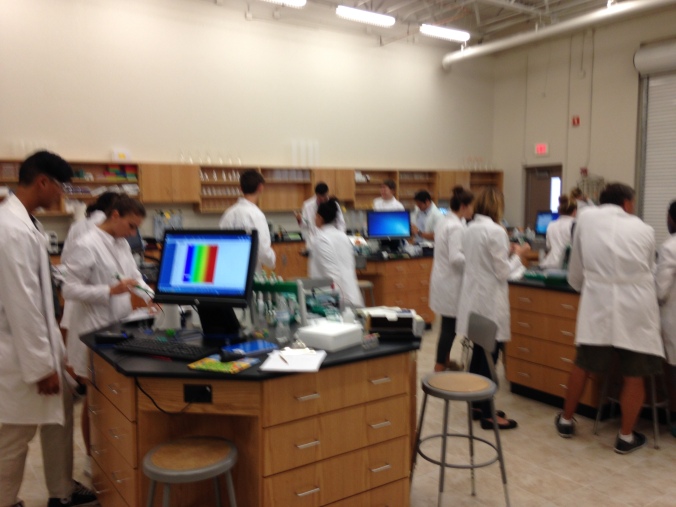 Vero Beach High School Biotechnology Lab
Vero Beach High School Biotechnology Lab
ON THE OCCASION OF THE 2016 VERO BEACH HIGH SCHOOL GRADUATION, WE ARE SPOTLIGHTING THE 2015-2016 BIOTECHNOLOGY COURSE, A TWO-YEAR OLD COURSE FALLING UNDER THE CAREER TECHNOLOGY PROGRAM.
This is the college placement list for Biotechnology students as of a few months ago, which does not include students who were in the class and had not yet chosen their college for next year:
4 – University of Central Florida
14 – University of Florida
7 – Florida State University
2 – Yale
1 – M. I. T.
1 – Middlebury College
1 – University of San Diego
2 – University of Tennessee
2 – Colorado University / Boulder
2 – Georgia Tech
2 – University of Miami
1 – North Carolina State
1 – United States Marine Corp.
1 – Alabama
1 – Clemson
1 – Gettysburg College
1 – Wake Forest
2 – Stetson
According to the UN Convention on Biological Diversity, Biotechnology is the use of living things and organisms to develop or make products or “any technological application that uses biological systems, living organisms or derivatives thereof, to make or modify products or processes for specific use.”
One student graduating this year was accepted to attend the University of Florida, but did not have the financial resources to attend. But when UF found out he had taken the VBHS Biotechnology class, he was accepted into to their BioScience (BioS) scholars program with a full-scholarship.
The BioS scholars program is a five-year BS/MS scholarship program, where students participate in research with a faculty mentor for four years. Only 10 new BioS scholars are selected each year.
This young man wants to go into life sciences research.
In this world, however, as our children grow and choose professions, there will be less and less to choose from.
At a recent May, 2016 SALT Conference in Las Vegas, where over 1,800 thought leaders, public policy leaders, business professionals and investors from over 42 countries and six continents met to discuss and debate on macro-economic trends, geopolitical political events and investment opportunities within the context of a dynamic global economy, Michael Bloomberg cited research that “40% of all jobs could be automated in 10 years.”
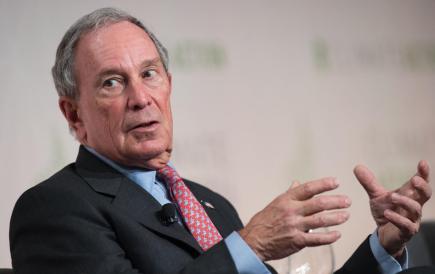
A recent article in the Economist quoted Bill Gates as saying at least a dozen job types will be taken over by robots and automation in the next two decades.

Some of the positions mentioned by Mr. Gates were commercial pilots, legal work, technical writing, telemarketers, accountants, retail workers and real estate agents.
http://www.futuristspeaker.com “predicts over 2 billion jobs will disappear by 2030. But that this is not a doom and gloom prediction, but rather a wake up call for the world.”
Mr. Jeff Bush, who started the Biotechnology program at VBHS in 2015, is addressing this “wake up call,” because, as BioSpace reported on July 10, 2014 “the future work force will be thriving with Biotech jobs by 2020.’’
Future biotech jobs reported by BioSpace include Biomedical Engineers, Bio Statisticians, Biochemists and Biophysicists, Nuclear Technicians and Medical Scientists. Others include Medical and Clinical Lab Technologists and Technicians, Microbiologists, Epidemiologists, R&D and Process Development Scientists, Regulatory QA/QC Bio Manufacturing Specialists and Bio Production Operators.
In fact a few of his students are already beginning to take one of these paths. One student is working at the Florida Medical Entomology Lab studying mosquitos and insects, one is working at the Lambeth Groves Microbiology Lab studying citrus greening, one is volunteering in the Vero Beach Marine Laboratory and eight students volunteered at the laboratory at Florida Atlantic University’s Harbor Branch.
Now, as to the specifics of what happens in the class and laboratory, I know first hand because I was invited to attend a class by my friend Alden Findley, a junior, who is an impressive young man and the Captain and founder of the VBHS Sailing Team.
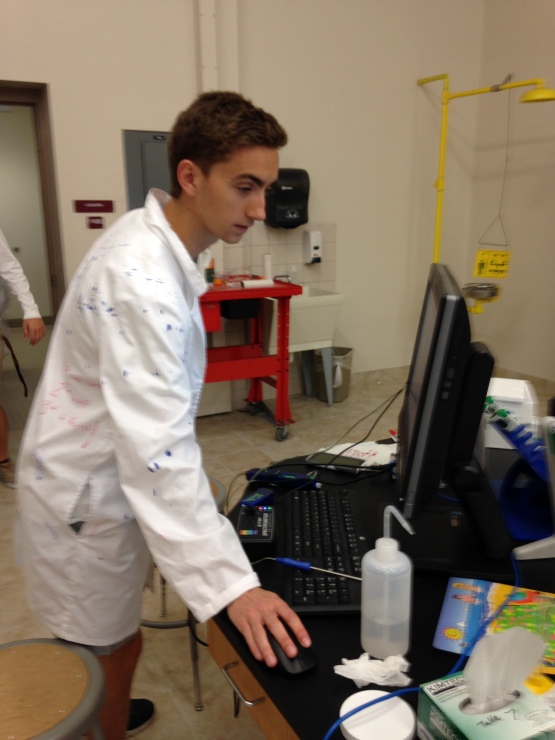
Alden Findley
The classroom adjoins the Biotechnology Lab. The class began in the classroom with Mr. Bush addressing the students as to the day’s objectives and then he let them loose into the lab, where I, with the students, had to wear a lab coat.
The lab is a sight to behold, all designed by Mr. Bush and Gina Hodges, with multiple stations where groups of two to three students work on different experiments.
It is equipped with digital Microscopes, Spectrometers, gel electrophoresis, petri dishes, PCR machines and other equipment found in professional laboratories. The students talked about enzymes, bacteria, cellulose, algae, substrates, Astrophysics, pipe heading, DNA, forensics and proteins.
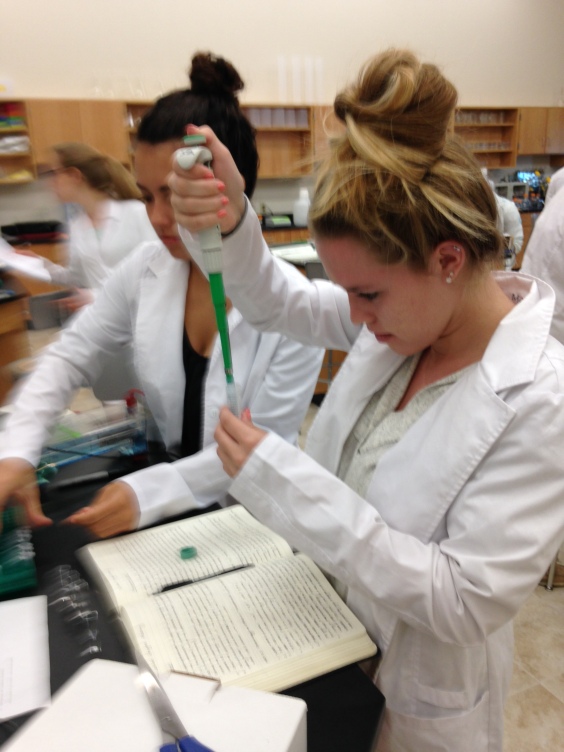
These two students told me a substrate is a molecule working with an enzyme that creates a reaction that for example, can result in a color change. The spectrometer tracks the progress of the reaction to determine protein concentration or reaction rates.
We are excited to spotlight two students who qualified to attend the Intel International Science and Engineering Fair (Intel ISEF), a program of Society & The Public (SSP), the world’s largest international pre-college science competition held in April, 2016.
Approximately 1,700 high school students from more than 75 countries, regions and territories are awarded a weeklong opportunity to showcase their independent research in an international stage, where doctoral level scientists review and judge their work. Students competed for approximately $ 4 million in prizes.
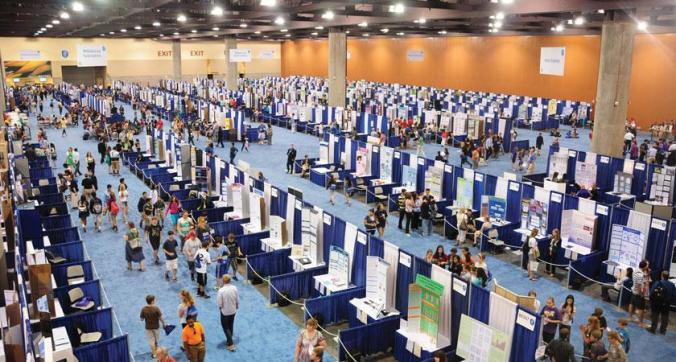
Intel ISEF Exhibit Hall
The two VBHS students who attended the Intel ISEF competition were winners of local and school-sponsored science fairs and SSP-affiliated regional and state fairs.
Brian and Spencer presented their Astrophysics research, where they tested the possibility of detecting Exoplanets; planets beyond our solar system, that orbit “Black Holes.” Inspired by the 2014 movie Interstellar, a science fiction film where a crew of astronauts traveled through a wormhole, which has the potential to connect extremely far distances such a billion light years or more. Brian believes “man needs to explore the universe out side our universe to explore natural resources and new places to live.”
They earned third place at this competition.
In this regard, according to www.techtimes.com Professor Stephen Hawking has written a paper with a new theory that solves the problem of what happens when information from the universe goes into black holes.
Professor Hawking’s new paper, titled “Soft hair on black holes,” could help him win his first Nobel Prize.

Hairy Black Hole
Working with a researcher from the U.S. Department of Agriculture in Ft. Pierce, Florida, another project being researched by Mr. Bush’s students is testing local citrus trees for citrus greening by getting DNA out of citrus leaves infected with Asian Citrus Psyllid, an insect that feeds on the leaves and stems of citrus trees. Asian Citrus Psyllid can transmit a disease that is fatal for citrus, called Huanglongbing (HLB), also known as citrus greening disease, which has been devastating for the Florida citrus industry.
Using the DNA, students are trying to map the locations and spread of the disease in Indian River County.
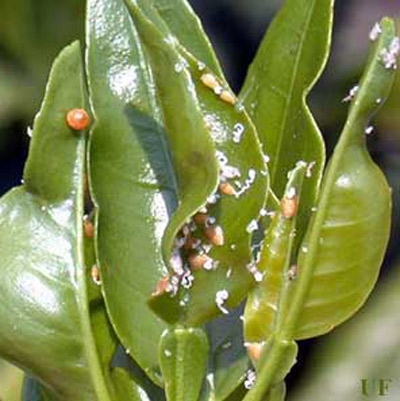
Asian Citrus Psyllid insects
Yet another research lab the students performed is in the area of biofuels. The goal is to try to develop an alternative to corn in creating the grain alcohol ethanol, which is blended with gasoline and used in motor vehicles.
The reason for developing an alternative to corn, is that corn is a staple food, eaten routinely and in such quantities that it constitutes a dominant portion of a standard diet and generally a significant portion of the intake of other nutrients.
When I visited the classroom they were experimenting with shitake mushrooms (grown by a studen in the class) to create ethanol. While not necessarily considered a staple food, they are ubiquitous. Researchers are also experimenting with Switchgrass, a native warm-season grass that is a leading biomass crop in the United States.
This in fact is similar to what INEOS Bio is researching at its Indian River BioEnery Center in Vero Beach; except instead of researching mushrooms INEOS bio’s is using breakthrough gasification and fermentation technology for conversion of biomass waste (e.g. alkali earth) into bioethanol.
There is ongoing collaboration between Mr. Bush’s Biotechnology class and INEOS Bio.
Biotechnology students will also be working with the Vero Beach Police Department in their forensic lab to study how DNA can be used to identify suspects. Here is a student’s forensic lab book where in the upper right hand corner you can see a comparison of DNA fingerprints from a simulated crime scene.
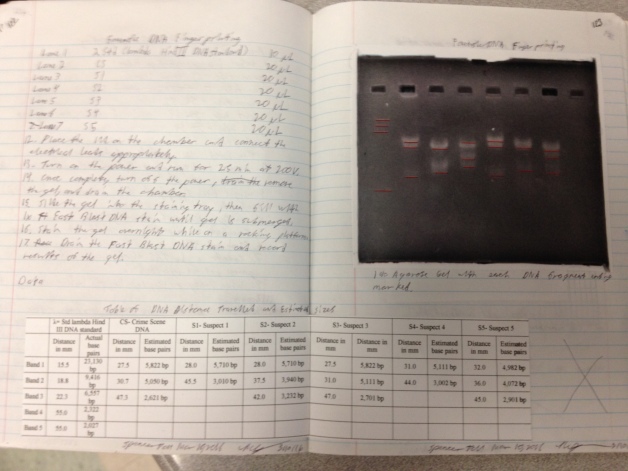
Aside from these specific research projects, the Biotechnology class is also preparing students for general expertise in laboratory techniques. It is commercially driven; preparing students to work in a variety of laboratories. The students take a test at the end of the second year of the course called the BACE exam (Biotechnician Assistant Credential Exam) administered by the State of Florida.
Curriculum in this regard, includes cleaning glass wear, organizing equipment, using Autoclaves to sterilize equipment, and learning how to mix solutions and establish quality control standards. Quality control standards affect every food production company in terms of analyzing the quality of bottles and cans before and after the food is bottled to determine bacterial count relative to salmonella, E coli and listeria.
Another discipline is to learn how to create a extensive lab book, such as the one illustrated below:
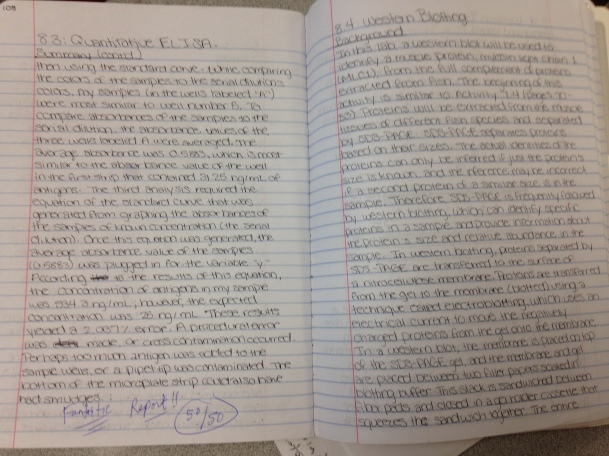
So what we have here in Vero Beach is a Biotechnology program, of which there are only a few in Florida, that is preparing students for a new generation of jobs at local companies and organizations such as Syngenta, USDA Fort Pierce, Scripps Research Institute; as well as other nationally known companies and research institutes such as Genentech, the May Institute for Infection, the University of Pennsylvania, Bayer Pharmaceutical and the University of Michigan Medical School, among so many others companies and schools of higher learning.
Here is Jeff Bush, with his students surrounding him. He says one of his main problems, despite the uncertainty of continued program funding, is that many of his students don’t want to leave at the end of the class because they care about their experiment and he continuously has to write late slips.
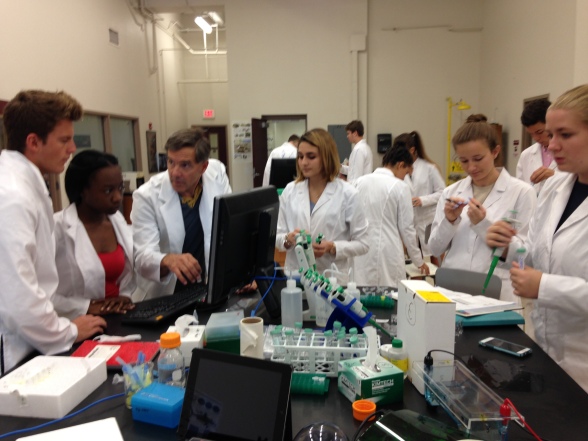
Mr. Bush and his students are trying to heal and change the world. www.bio.org reports that healing the world means:
- Reducing rates of infectious disease;
- Saving millions of children’s lives;
- Changing the odds of serious, life threatening conditions affecting millions around the world;
- Tailoring treatments to minimize health risks and side effects;
- Creating more precise tools for disease protection;
- Combating serious illnesses and everyday threats confronting the developed world;
- Streamlining the steps in chemical manufacturing processes by 80 percent or more;
- Lowering the temperature for cleaning clothes and potentially saving 4.1 billion annually;
- Improving manufacturing process efficiency to save 50 percent or more on operating costs;
- Reducing use of and reliance on petrochemicals;
- Using biofuels to cut greenhouse gas emissions by 52 percent or more;
- Decreasing water usage and waste generation;
- Tapping into the full potential of traditional biomass waste products;
- Generating higher crop yields with fewer inputs;
- Lowering volumes of agricultural chemicals required by crops-limiting the run-off of these products into the environment;
- Using biotech crops that need fewer applications of pesticides and that allow farmers to reduce tilling farmland;
- Developing crops with enhanced nutrition profiles that solve vitamin and nutrient deficiencies;
- Producing foods free of allergens and toxins such a mycotoxin; and;
- Improving food and crop oil content to help improve cardiovascular health.
As always within one story there is another.
After being awestruck by the class, we later learned that the continued funding of the biotechnology course was in jeopardy, having do to with restrictions on CAPE funds provided by the State of Florida to high schools as created by the Florida Career and Professional Act enacted in 2013. CAPE funds had previously funded the program.
However, at a recent Indian River School Board meeting, when asked if the Biotechnology class would continued to be funded, the Superintendent of Schools, Dr. Mark Rendell and Michael Arnett, who was recently appointed by Dr. Rindell to manage the Career Technology Program, concurrently responded that yes, it will be funded out of general funds.
Mr. Bush will continue on to teach, inspire, engage, motivate and promote his students.
Specialized areas of study like this are the wave of the future for high schools. What we need are more legislators who recognize their importance. How about reducing most manufacturing subsidies and using that money to support programs like this? Young brains need cultivation, not corn for ethanol.
LikeLike
Wow!Excellent program. Impressed with the number of VBHS sailing team members taking the class.
LikeLike
I was very impressed and excited when I heard of this program at VBHS. With continued community support these students can make a difference in the world in which we live. It would be very fortunate if other area high schools all offered a different program of study such as this for students. Opportunities of this magnitude make education life long while the students are without limits and boundaries.
LikeLike